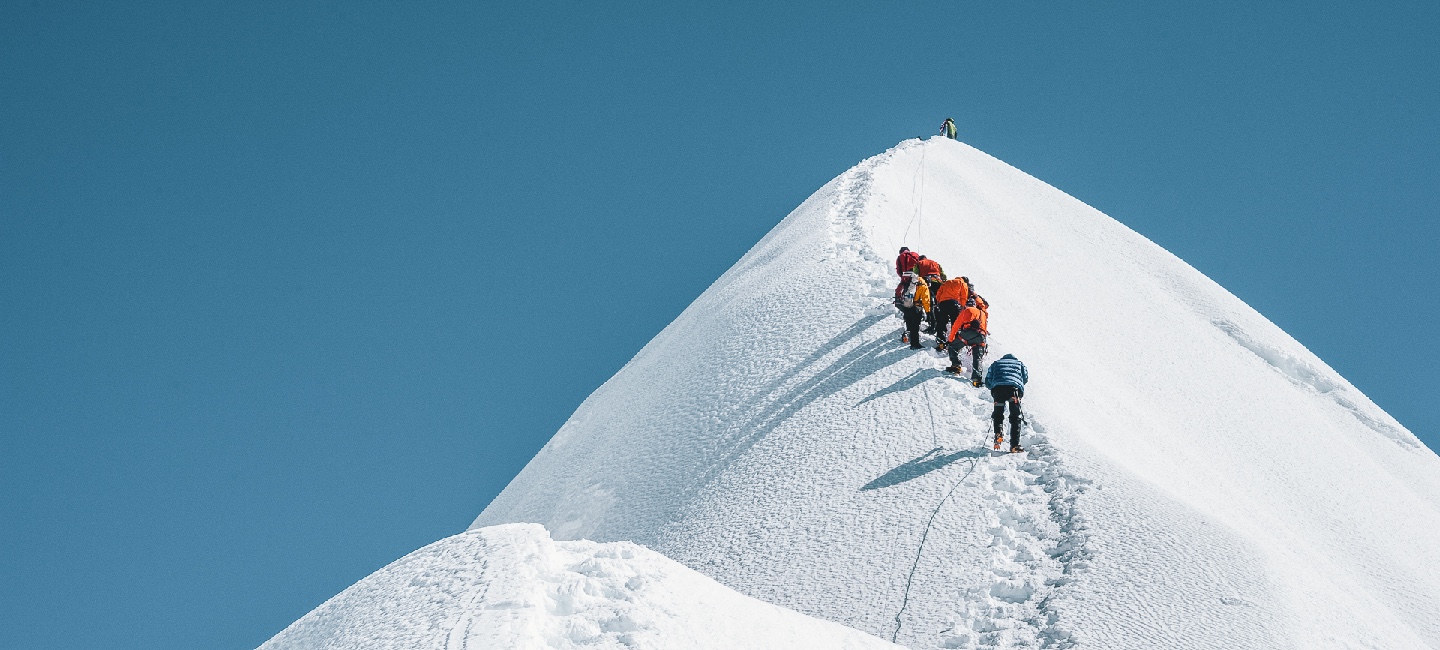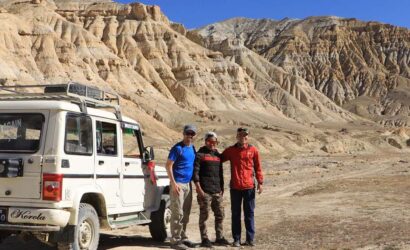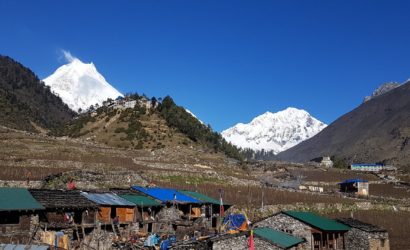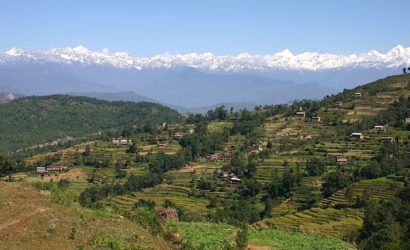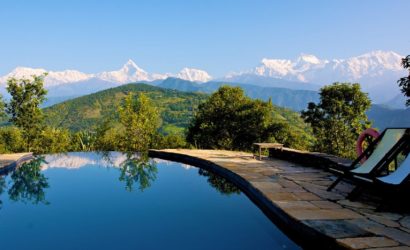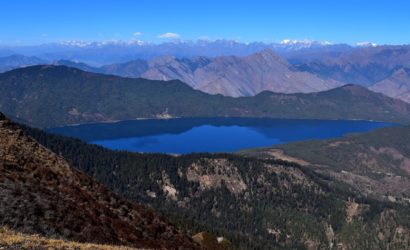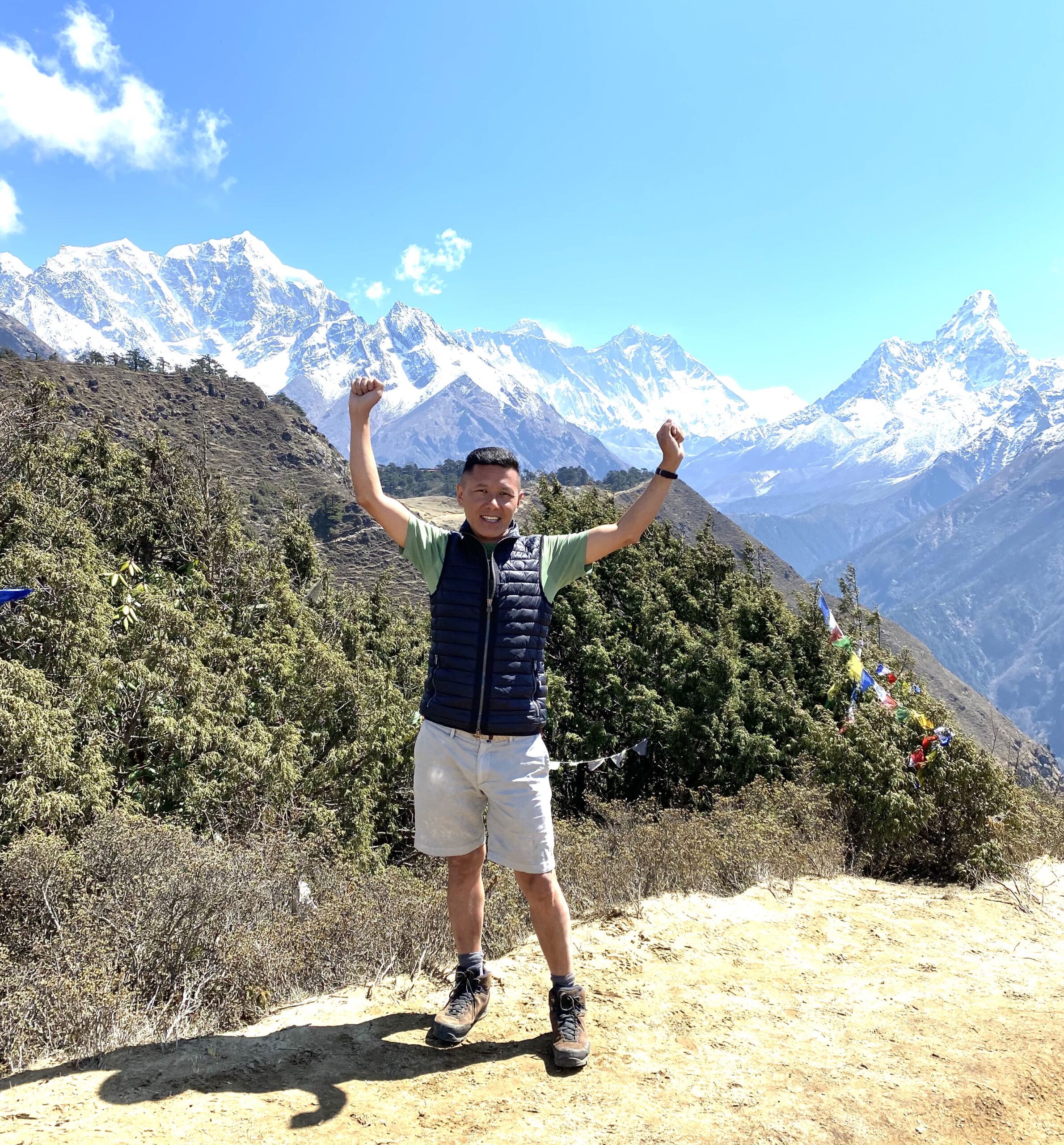The Everest Base Camp with Island Peak climbing is a legendary trip that combines trekking to Mount Everest’s base camp with a climb of the Island Peak. It is best suited for those looking for a more thrilling experience than regular trekking journeys.
It takes place in Nepal’s most beautiful Khumbu region and offers many highlights. The trip package includes the best features and attributes of the region. You will have a thrilling adventure!
The trip to the Everest Base Camp with Island Peak climbing starts with a scenic flight to Lukla, from where the trail passes through ethnic Sherpa villages like Phakding, Namche Bazaar, Tengboche, and many others. Hike to the Kala-patthar view point for panoramic views of the entire Mount Everest range.
Light butter-lamps in the Tengboche monastery and enjoy the views of famous mountain peaks such as Ama Dablam, Kongdi RI, Thamserku, Lhotse, Nuptse, and Mount Everest, among others. Then feel the joy in the accomplishment of reaching the world’s tallest mountain’s base camp.
The beauty of the wild and cold mountains that unfolds right before our eyes is a reward for all of our struggles climbing up the ropes.
Island Peak Climbing Difficulty
Climbing Island Peak (Imja Tse) is a challenging, but if you are physically fit, we can get you to the summit. If you’ve already hiked to altitude, then this is a fantastic next challenge. The first part of the ascent is physically demanding because you are trekking up rough terrain at over 5000m.
This part is definitely non-technical. You’ll then reach at the glacier field, where you’ll need to rope up and put on crampons. There is a risk of falling into snow-covered crevasses along this section.
To cross, these will have ladders strapped in place. This can be challenging, but you will always be on safety lines. Finally, you reach at the foot of the headwall. This is the most difficult part of the climb because the ascent is steep and the air is at its thinnest.
Fixed lines makes the climbing route easier and safer, but reaching the summit ridge will require a lot of determination. The ascent from the summit ridge to the top is a short and relatively easy.
Upon your arrival in the Kathmandu airport after completing your custom formalities Visa, etc. pick up your luggage and look for our airport representative from Himalaya Discovery, who will display your name on the board at the arrival gate. You will be greeted by our representative and transferred to your hotel by private tourist vehicle.
Today, our team will meet you in the morning to check the equipment you brought and take you to the equipment rental shop. Before you leave for the Himalayas, we will make sure that you have quality climbing gears that fit properly.
Today, there’s also a trip briefing on last-minute specifics about your trip and an early lights-out: you have a big day ahead.
You may want to visit Durbar Square in the heart of the old city, where the old Royal Palace with its impressive woodcarving is located. The whole area is a maze of images and temples.
Narrow alleys leading away from the square in all directions are full of the most amazing variety of shops and stalls. Some of these sites are World Heritage Sites, such as the historic Bhaktapur Durbar Square, the famous ‘Monkey Temple’ Swayambhunath, and Buddhist shrines.
During 35-minute flight from Kathmandu to Lukla (2,860m), we enjoy one of the most spectacular air routes in the world leading on a hillside surrounded by high Himalayan peaks. We meet our other crew members in Lukla, a gateway destination from where our trek begins, and start packing and arranging with them.
We start trekking from Lukla. After an hour of gradual descent, we will arrive at a Cheplung village with a view of Mt. Khumbila (5,761m), a sacred mountain that has never been climbed. We then gradually descend from Cheplung to Phakding, where we will spend the night. Overnight at guesthouse.
We continue our trip along the banks of the Dudhkosi (milk river), crossing this milk river several times on exciting suspension bridges laden with Buddhist peace flags. After entering Everest National Park, the trail climbs steeply with beautiful landscapes.
Namche Bazaar, also known as the Everest Gateway, is home to many good restaurants, hotels, guesthouses, shops, money exchange, an internet cafe, and a bakery. Namche Bazaar is one of the most popular villages on the Everest route. Overnight at guesthouse.
Today is the day reserved for acclimatization. Health experts advise that we stay active and move around even on rest day instead of being idle. For this day, there are a few options.
We can either stroll around Namche’s quaint villages and meet the Sherpa people and their rich culture, or we can hike up to the Everest View Hotel and get a close-up view of the mighty Everest. Trekkers may also visit the local museum, which showcases the area’s native flora and fauna as well as the history of the Mount Everest region.
A hike to Khumjung village (5 hours) may also be an option for trekkers who want to hike for a little longer. We can visit the Edmund Hillary School and Khumjung Monastery while in the village (a monastery famous for housing the Yeti’s head!) Overnight at guesthouse.
After breakfast, we’ll head towards Tengboche. From Namche to Phunki is an easy walk. We ascend from Phunki-thanga to Tengboche, a village that is home to the world-famous Tengboche monastery, the largest monastery in the Everest region.
It is surrounded by the Sagarmatha National Park (a UNESCO World Heritage Site of “outstanding universal value”) and offers a panoramic 360-degree view of the Himalayas, including Mt. Everest, Nuptse, Lhotse, Ama Dablam, and Thamserku. The monastery opens at 3:00 p.m., so if we’re lucky, we might get to see a ceremony. Overnight at guesthouse.
The Himalayas as its backdrop, the Tengboche monastery is in an ideal location. We visit the monastery in the evening or morning and take pictures of the monastery and the incredible views. We descend through a forest for about half an hour before crossing a river. Next, we hike uphill, notice that the landscape becomes drier as we ascend higher.
We walk through Pangboche, a traditional Sherpa village, before arriving at Pheriche, a beautiful riverside village. We’ll also see a small helipad here, which is used for helicopter rescues during emergencies. We may even attend a class with a mountain specialist at a medical clinic in Pheriche. Overnight at guesthouse.
The gradual ascend to Lobuche will be enjoyable as we get closer to the snow-clad giants. We will arrive in Thukla after a 45-60 mins hike. We’ll stop for lunch there before continuing up to a flat area with several memorials dedicated to the climbers who died on Everest. Then we’ll climb out of the valley and descend to the Lobuche yak pastures. Overnight at guesthouse.
After a short hike through the meadows, you can see the Khumbu glacier. Straight ahead is Kala-patthar, which offers the best view of Mt. Everest’s south face and surrounding peaks. After a few hours, we’ll get to Gorekshep and continue our journey to Everest Base Camp.
There’s not much altitude gain, but there are a lot of ups and downs, which, combined with elevation, can be an exhausting hike – but the journey is worthwhile. After about 3 hours of hiking, you’ll arrive at the base camp and can enjoy a spectacular view of the Khumbu glacier and icefall, where the Everest expedition starts. Then we’ll return to Gorakshep. Overnight at guesthouse.
We will hike to Kala Patthar 5,545m early in the morning to see the sunrise over Mt. Everest 8,848m, Mt. Lhotse 8516m, Mt. Makalu 8481m, Mt. Cho Oyu 8,188m, and other surrounding peaks.
After spending sometime in Kala-patthar, we return to Gorakshep and then take the route that passes through Lobuche to reach Dingboche village, which has a magnificent view of Ama Dablam. Overnight at guesthouse.
We’ll leave Dingboche at a leisurely pace, following the Imja Valley with stunning views of Ama Dablam dominating the skyline and the moraines that flow from Lhotse (8,501 m) to the sand flats at Pareshaya Gyab. We’ll reach at Island Peak’s base camp in the mid-afternoon. We’ll be staying at the tented camp for a day or two.
Pre-Climb Training: After lunch, our climbing guide will provide training on peak climbing techniques and how to use climbing gears like an ice axe, climbing boots and crampons, a harness, an ascender, and how to ascend and descend using ropes. Although prior climbing experience is not required for Island Peak Climbing, we believe that it will boost your confidence and climbing skills, increasing your chances of reaching the summit and fully enjoy the experience. Overnight at tent camp.
Today, we start early to achieve the Island Peak Summit. It is best if we reach the summit before noon time as strong winds after midday can create obstacles to the successful summit.
We’ll have to cross many crevasses and overcome difficult parts with ropes, ice axes, harnesses, and other climbing gear. We’ll reach the summit of this physically demanding yet adventurous climb of Island Peak at the same time, guided by our native Sherpa climbing experts.
From the top of the Island peak, you can see Mt. Lhotse 8501m, Mt. Makalu 8475m, Lhotse Middle Peak 8410m, Lhotse Shar 8383 m, Mt. Nuptse 7879m, Mt. Baruntse 7129m, and other high peaks. After reaching the summit, we slowly retrace our steps back toward Island Peak Base Camp. Overnight at tent camp.
After successfully summit of the Island Peak, we return to Dingboche via the same route from Island Peak Base Camp. Overnight at guesthouse.
We trek back through the hillside covered by juniper and rhododendron trees. Our trail follows the Dudh Koshi gorge, descending rapidly through pine forests after crossing the buddhist peace-flags festooned bridge over the Dudh Koshi River. We might see colorful pheasants and mountain goats in the forest.
The path eventually leads to Sansa, from where we can see Ama Dablam, Thamserku, and Nuptse mountains. Before reaching Namche Bazaar, we also pass winding trails then through a forest. Overnight at guesthouse.
Finally, we return to Lukla, where the journey began, which will seem like a lifetime ago. Enjoying time to reflect on the trip as a group and the personal achievement of all those who participated. You’ll also have time to discover the town. Overnight at guesthouse.
Enjoying your last view of the Himalayas you have visited recently for one last time on the scenic flight back to Kathmandu.
It’s also a spare day in case of bad weather in Lukla. If you want to take some Nepalese gifts for friends and family, go to some nearby shops or go out in Thamel for typical Nepalese goods.
Throughout the day, you can rest and relax. In the evening, we will have a farewell dinner with cultural performances in a traditional Nepalese restaurant.
Today you will say goodbye to the wonderful journey and return home. We will drop you off at the airport in according to your flight schedule.

